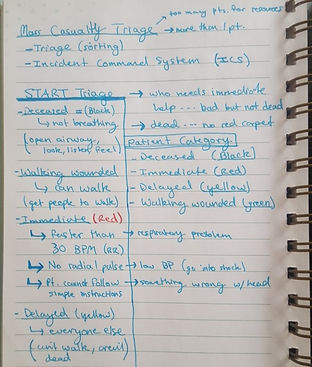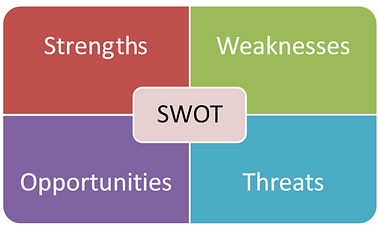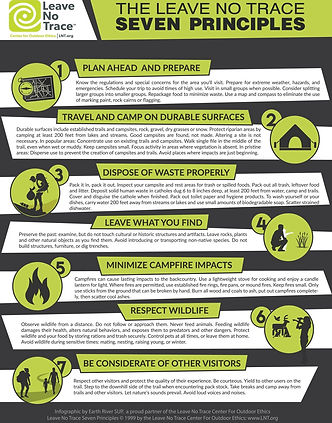
_edited.jpg)
Christina's Graduation with Leadership Distinction in Research e-portfolio
Planning Promotes Progress,
but adaptability is essential.

Notes from Wilderness First Responder Training
It is not the strongest of the species that survives, nor the most intelligent that survives. It is the one that is the most adaptable to change, that lives within the means available and works co-operatively against common threats.
Lightning strikes. Giant tree splinters soar through the air as the night is illuminated by electricity. As you look to your left, one friend is unconscious and the other is impaired by the tree shard you saw briefly flying. And wait, where is your third friend? What do you do now? You make a plan and take action. During my Wilderness First Responder (WFR) training, this was the scenario I was given as team lead, which meant I made the plan and delegated actions to my team to help the three injured victims. Before this scenario, I had engaged in 80 hours of interactive coursework that provided me a framework to make this plan (see to the right). I learned about what injuries should be prioritized in any wilderness emergency scenario, which guided the plan, however, once in the real scenario my decisions accounted for the relevant information. As team lead in my WFR training, I planned, adapted my plan, and reflected upon what could have been done better afterward. In research and all other facets of life, these three steps, planning, adapting, and reflecting are essential to improve and progress.
Throughout my four years at the University of South Carolina (UofSC), it seems like planning and adapting have been constant. Planning to study abroad, planning to be a successful medical school applicant, planning to surpass past goals for St. Jude Up ‘til Dawn, planning for weekend hiking trips, and then adapting these plans when new opportunities or challenges arise. In the realm of research, clinical trials must publish their methods before the experiment, emphasizing the importance of a well thought through plan. As scientists learn more about different biological processes through research their theories and practices must be adapted. More broadly, as Charles Darwin’s theory of evolution suggests, “It is not the strongest of the species that survives, nor the most intelligent that survives. It is the one that is the most adaptable to change, that lives within the means available and works co-operatively against common threats.” Which could not be more true during this COVID-19 pandemic. It is important to note that even with the planning that occurs throughout each stage of life, the research process, and emergency preparedness, results do not always turn out as planned (hence the essentiality of adapting). Hypotheses are not supported, one does not end up in the career they imagined, and plans change. This does not mean the planning was for nothing, or that the experiment was a failure. In fact, quite the opposite is true. If circumstances had turned out exactly as expected that would mean everything was already known, that there was nowhere to progress.
The importance of planning, adapting, and reflecting has been emphasized throughout much of my public health curriculum. In HPEB 300: Introduction to Health Promotion Behavior and Education, my team and I spent the whole semester planning a colorectal cancer (CRC) community intervention which begins to show how long the planning stage of an intervention can be (WTC - Artifact 1). Even this four-month-long process is a fraction of what it may take for some health promotion interventions to be planned or for some research projects to be fully approved. Several revisions and committee reviews are necessary, and feedback must be reflected upon and incorporated into the new plan. During the planning of the CRC intervention, I applied all that I had learned about systematic planning from Hunnitcutt’s Four Reasons for Systematic Planning (Hunnitcutt, 2007). These include: 1) forcing planners to think through details in advance, 2) promoting transparency, 3) encouraging ownership through empowering the planners, and 4) creating alignment within an organization.
Many of these concepts carry over to both physical science experiment planning and the business side of healthcare. As mentioned above, clinical trials are required to publish an entire paper on methods. This promotes transparency and forces planners to think through details which are essential for a valid and reliable clinical trial free of bias. In HSPM 500: Introduction to Healthcare Management, I learned the process and importance of quality improvement and strategic planning. Much of what I learned emphasized the importance of reflecting and adapting once again. Hospitals (and all companies) are constantly adapting their procedures to align with the most current research findings and reflecting on areas to improve. In one case study, I looked at how a hospital could improve its response to patients who have signs of being sex trafficked; using a Strengths, Weaknesses, Opportunities, and Threats (SWOT) analysis commonly used by organizations for strategic planning and problem solving (WTC - Artifact 2). This project, and specifically the SWOT analysis, allowed me to reflect on the company’s areas of growth while utilizing their assets to propose (with a little bit of research) an evidence-based solution.



Outside of academia, during my time serving as a Resident Mentor (a peer leader position in which I provided social and academic support to approximately 33 students each year for 3 years in an on-campus residential community), I spent two years planning and adapting the new Outdoor Recreation and Adventure Living Learning Community. Through the planning process, I came to realize which parts were not feasible as a first-year pilot community (including a trip to Mt. Everest proposed by Dr. Patrick Hickey). During the early implementation of the community, I realized how important it was that I had thought about details in advance, had transparency with my supervisors and residents, and aligned with university housings residential curriculum. All of which were aided by several meetings and the planning document (BTC Artifact 1). In the realm of adventure trip leading, even outdoor ethics principles such as, Leave No Trace (LNT) emphasize the importance of planning. Rule number one is to plan and be prepared (see to the left). For example, a lightning plan is important to discuss so people are prepared if lightning occurs to hopefully avoid the scenario described at the beginning of this page. However, this plan may not always be necessary or may need to be adapted in the moment, as unexpected things often occur in nature. Nonetheless, if this plan was not in place, people may make the wrong decisions when choosing how to react. Essentially, planning turns reactivity into proactivity that helps people adapt gracefully.
This is true in research as well. As mentioned earlier, many stages of planning go into an experiment before the actual experiment occurs. During my independent study, most of my time was spent planning and revising plans such as selecting the right type of stimuli (sorting through hundreds of faces), editing the Internal Review Board (IRB) proposal, and developing the right code for MATLAB. Although Covid-19 interrupted the completion of the project, I imagine that all the planning would help the experiment run much smoother than if that stage was glossed over.
Aside from short term planning, long term life planning and applying to several fellowships have led me to discover and progress with intention. I learned that epidemiologists are often doctors in Colombia through applying for the Rotary Global Grant (BTC Artifact 2), that the London School of Hygiene and Tropical Medicine has a specific global mental health program when applying for the Marshall (read more in BTC Artifact 3 – Marshall Application Essays), that Erasmus has a public health master’s program, that George Washington University has a good medical school program that incorporates public health and policy advocacy into the curriculum. During each competitive scholarship and fellowship journey, I detailed and adjusted what my future would look like if I received the prestigious award. Although I never was chosen to receive one of the fellowships above, if I had never embarked on the endeavor to progress by planning my future around an uncertain possibility, I would not have the plans that were not planned before planning the other plans. After redesigning my future goals over and over, I have come to understand how important it is to keep planning despite uncertainty. As someone who loves to travel internationally and is a 2020-2021 Fulbright Scholar in the midst of a Pandemic, this is more true than ever. I will continue to plan for and adapt to the ever-changing timeline that my future holds.
Entering college, I prepared to be a successful medical school applicant complete with independent research experience through careful planning. In my four-year trek to carry out this forethought, among others, I came across many times when arrangements did not go as expected. Although I did successfully complete my graduation with leadership distinction in research, lab experiments did not always go as anticipated, my reaction to observing my first live birth shocked me, even though I thought I wanted to be an OB-GYN. Implementation of the new Living Learning Community, among other things, was interrupted by a global pandemic, derailing my plans over and over. This allowed me to learn the importance of resiliency and flexibility while laying new tracks to be successful. All of these academic and extra-curricular experiences instilled further the importance of planning, adapting, and reflecting on my progress and the progress of all things research-related and beyond. Although my future is not certain, I am certain that with the plans I have, and the ability to adjust those plans when needed, I will be successful in whatever I venture to next.
Plans are worthless, but planning is everything.